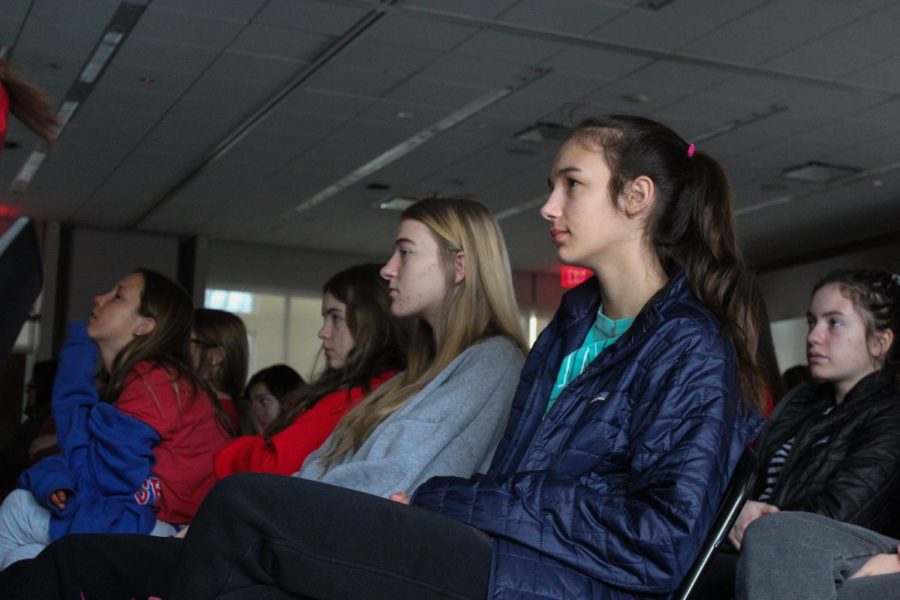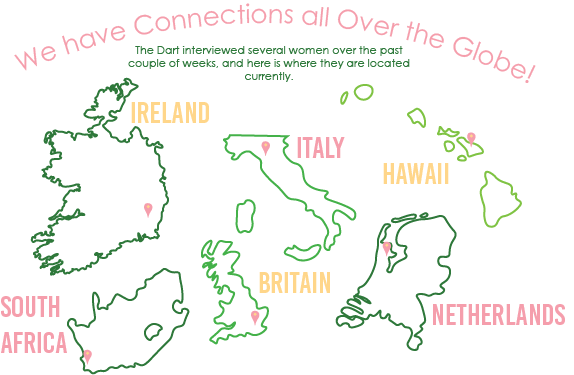Learning through observing
STA watched the film “True Justice: Bryan Stevenson’s Fight For Equality” Jan. 31, marking the fourth year in a row the whole school has watched a movie together. The Dart explores the efficiency of teaching through films and the influence it can have.
Sophomores Rachel Pryor, on the left, and Jessie Borchert watch the movie “True Justice: Bryan Stevenson’s Fight for Equality” in Windmoor, Jan. 31. This is the fourth year STA has shown a movie to the entire school. photo by Ella Norton
February 10, 2020
When now junior Sally Swinney was in her first year of high school, she filed into the auditorium with her classmates to watch the movie “Big Sonia.” Swinney, who worked at a movie theater at the time and had seen the movie previously, found herself enjoying the movie once more and learning more about the Holocaust, a topic she previously didn’t know too much about. For Swinney, watching a movie to learn allowed her to process the information in a different way than she had before.
“I think [learning] is different to actually see it with your own eyes and to witness change happening in the world,” Swinney said. “When you read about it you can sometimes just skim over it and not get the whole picture or understand what it’s saying.”
STA students and faculty watched a film as a whole school again Jan. 31. The documentary “True Justice: Bryan Stevenson’s Fight for Equality” focuses on the life of public interest attorney Bryan Stevenson and his battle with inequality in the justice system.
The film was introduced by equity outreach coordinator Kelly McKee and administration who requested STA view the film. “True Justice” was shown to finish Catholic Schools Week and to kick off Black History Month. Campus ministry leader Andrea Arredondo believes the film opens up the conversation on relevant topics for a Catholic school to discuss.
“The Sisters of St. Joseph, they’re about unifying love, and so they talk to us about love of God and neighbor without distinction,” Arredondo said. “I think social justice calls us to look at the structures in our society, and as a Sisters of St. Joseph and a Catholic school, I think we are even more responsible to look into these issues because of the legacy that we carry on.”
Director of equity outreach and inclusive education Brianna Walker similarly believes that showing this film to STA is important, especially since it tackles the morality of capital punishment.
“As we continue to ensure that students of STA are becoming critical thinkers about the world that they live in, it’s important to make sure that we challenge them to do so,” Walker said. “We can only do that by engaging in conversation about controversial subjects such as this one.”
According to Walker, STA encourages engagement with social justice as a tool of empowerment and in alignment with the mission of the school.
“Right in our mission we vow to empower you all to change the world,” Walker said. “We’d be remiss to hold this transformative paradigm and not act on it.”
Since working at STA in 2018, Walker has seen the films have different impacts on people.
“Honestly, I’ve seen it go both ways,” Walker said. “When it comes to the subject matter of this movie in particular and others like it, I’ve seen people get inspired to learn more and see how they as an individual can be a beacon of change. I’ve also seen people feel regret and apologetic, which definitely is not the intention of these movies.”
Walker believes that part of what makes movies so impactful is because it puts faces to the issue, creating a visual of the problem.
“So often, we have workshops on implicit bias, we hear about slavery, we learn about the Trail of Tears, but when we can see injustice in the face and learn that things like this are in fact still happening today, it’s much more impactful,” Walker said. “I think showing a movie is just as effective as bringing in a speaker, taking students through an online training or even making this a topic choice for research papers in class. Not everyone will get the same things from each method, but at least students are given the option.”
Arredondo believes that Stevenson himself will have an effect on students because he is an “admirable man” who is articulate, while also using humanistic terms, to discuss topics such as the justice system and death penalty.
“He makes these topics really close to your heart and at the same time knows all the facts,” Arredondo said. “And there are parts of the film too that are a little jarring so that too is sometimes hard to see, but it also makes an impact because you realize the depth of injustice that is going on.”
For Swinney, by watching movies through STA, she found herself able to consider different points of view.
“I thought it was really cool and interesting that STA provided that opportunity for students to see movies like that,” Swinney said. “I loved watching ‘The Hate U Give,’ I thought it was really interesting and brought a whole new perspective that I couldn’t see as a white person.”
However, senior Liv Richardson does not believe that movies are an absolutely successful way to teach students about social justice.
“I think that movies are very effective, but I don’t think people want to be forced to learn a lesson,” Richardson said. “We are in high school and high school does form you a lot, but I would say a lot of your morals are formed when you’re little and what you believe is how you grew up. I think that [teaching about social justice] needs to be more subtle.”
Richardson does note that films can be an important reminder of current events, especially in a society that she sees as desensitized.
“Everything that happens affects you in some way — a lot of things that were traumatic or big in our history had a big impact, we just don’t see them everyday,” Richardson said. “To reopen your eyes and see how we got here and how you formed as a person, it’s just very important that we do.”
Other than viewing the films, Richardson believes that people at STA can better address social justice through changing the language they use, especially around sensitive topics such as race.
“I believe that racism is a learned behavior and that comes through language,” Richardson said. “If we learn how to use different words and make sure that girls weren’t actively attacking people and just change a little bit of the behavior, then it wouldn’t be a problem.”
For Walker, after watching “True Justice” she hopes students become more comfortable engaging in “courageous conversations” with each other, as well as recognize history as a tool to understanding this country now. Walker also thinks that there are other ways that we can open up the conversation around social justice.
“Social justice doesn’t just have to be formulated around race,” Walker said. “There are plenty of conversations to be had about all types of aspects of social justice. It’s pinpointing the part of social justice to focus on that gets difficult.”
When Arredondo watched ”True Justice,”” she was struck by the sense of purpose Stevenson has and hopes that students can walk away with a similar feeling. She also hopes that students are able to recognize the injustice the film portrays and learn from the whole experience.
“I also hope it makes them think a lot about oppression and systemic injustice,” Arredondo said. “I know it comes up in your classes here and in different readings and history lessons, but I think this film shines a really bright spotlight on what injustice looks like. It would be hard to miss that so I hope every student at some point is like ‘wow I never knew that’ and has one of those moments.”









